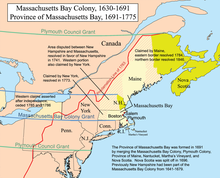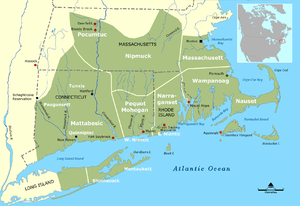Massachusetts Bay Colony

The Massachusetts Bay Colony was a 17th-century British settlement founded by Puritans on the East Coast of North America. Later called New England, the colony included the states of Massachusetts, Maine, New Hampshire, Rhode Island, and Connecticut.[1]: 58
The Massachusetts Bay Company, founded in 1628, brought around 20,000 people to the colony.[1]: 33, 47–48 It was one of two companies which brought settlers in the New World.[1]: 47–48 The other, called the Dorchester Company, was a failure.
At first the colonists had a friendly relationship with local Native American tribes. These included the Massachusett, Wampanoag, Nipmuc, Narragansett, and Pequot Mohegan tribes, among others. However, as more Europeans moved to the New World, conflicts over land borders arose. Along with differences in culture and customs, these conflicts led to the Pequot War (1636–1638) and then to King Philip's War (1675–1676). Some Native Americans moved to other places after these wars. Others remained peacefully in the Massachusetts Bay Colony.
The colony did well economically trading with England and the West Indies.
Initially the colony did well economically and made money trading with England and the West Indies. In 1692, Sir William Phips arrived and combined the Massachusetts Bay and Plymouth Colonies. The colonists helped run the government and decide how to spend its money.
Earlier times
[change | change source]
From the earliest times, many Native American tribes lived in what is now New England. They farmed and hunted within their own land borders and usually did not cross each other's land.[2] Early in the 1600s, Samuel de Champlain and John Smith mapped New England and the location of various tribes.[3]
Living in the New World was very hard work for the first settlers. Many became ill and died though the cold winter. There was not enough food, and many people in the group decided to return to England after a year.[4] For awhile there was no more talk of settling people in the New World,[5] although English ships did still come to the New England area to fish and trade with Native Americans.[6]
Plymouth Colony
[change | change source]In November 1620, a group of Europeans started the Plymouth Colony.[7] After nearby settlements failed, some of the group joined the Plymouth Colony or lived near it; others returned to England.[8]
The people of Plymouth faced many problems during the colony's first years, and they could not pay back their investors. In 1627 the companies left the colonists to take care of themselves.[9]
In 1622 two of the colony's leaders, Edward Winslow and William Bradford, published a booklet about the Mayflower and the colony they created. It was called Mourt's Relation (full title: A Relation or Journal of the Beginning and Proceedings of the English Plantation Settled at Plimoth in New England). Though the two men express differing opinions, the booklet's purpose was to encourage people to come and settle in the New World.[10][11][12]
References
[change | change source]- ↑ 1.0 1.1 1.2 William Dummer Northend, A Civil, Religious and Social History of the Massachusetts Colony and its Settlements from the Landing at Cape Ann in 1649 to the Death of Governor Winthrop in 1649 (Boston: Estes and Lauriat Pub.)
- ↑ Hart, p. 1:129
- ↑ Hart, pp. 1:127–128
- ↑ Thayer, pp. 13–216
- ↑ Vaughan, p. 14
- ↑ Vaughan, p. 15
- ↑ Hart, pp. 1:67–70
- ↑ Adams and Nash, pp. 15–34
- ↑ Stratton, p. 27
- ↑ Heath, pp. xiii–xv
- ↑ Labaree, p. 26
- ↑ Adams and Nash, pp. 29–34
References and further reading
[change | change source]- Adams, Charles Francis; Nash, Gilbert (1905). Wessagusset and Weymouth. Weymouth, MA: Weymouth Historical Society. OCLC 1066255.
- Adams, Brooks (1899). The Emancipation of Massachusetts.
- Adams, Charles; Nash, Gilbert (1905). Wessagusset and Weymouth. Weymouth, MA: Weymouth Historical Society. OCLC 1066255.
- Addison, Albert Christopher (1912). The Romantic Story of the Puritan Fathers: And Their Founding of New Boston. L.C. Page & Co.
- Anderson, Robert Charles (1995). The Great Migration Begins: Immigrants to New England, 1620–1633. Boston, MA: New England Historic Genealogical Society. ISBN 978-0-88082-120-9. OCLC 42469253.
- Bowen, Clarence Winthrop (1882). The Boundary Disputes of Connecticut. Boston: James R. Osgood. OCLC 1994357.
- Bremer, Francis (2003). John Winthrop: America's Forgotten Founder. New York: Oxford University Press. ISBN 978-0-19-514913-5. OCLC 237802295.
- Bremer, Francis; Webster, Tom (2006). Puritans and Puritanism in Europe and America: a Comprehensive Encyclopedia. ABC-CLIO. ISBN 978-1-57607-678-1.
- Dow, George Francis (1967) [1935]. Everyday Life in the Massachusetts Bay Colony. New York: Benjamin Blom.
- Field, Edward, ed. (1902). State of Rhode Island and Providence Plantations at the End of the Century: a History. Boston, MA: Mason Publishing. OCLC 14245880.
- Fry, William Henry (1908). New Hampshire as a Royal Province. New York: Columbia University. OCLC 1981065.
- Guiley, Rosemary (2008) [1999]. The Encyclopedia of Witches, Witchcraft, and Wicca. New York: Facts on File. ISBN 9781438126845. OCLC 435912011.
- Hart, Albert Bushnell, ed. (1927). Commonwealth History of Massachusetts. New York: The States History Company. OCLC 1543273. (five volume history of Massachusetts until the early 20th century)
- Hayes, Kevin (2008). The Oxford Handbook of Early American Literature. Oxford: Oxford University Press. ISBN 9780195187274. OCLC 132584511.
- Heath, Dwight, ed. (1986) [1963]. Mourt's Relation: A Journal of the Pilgrims at Plymouth. Cambridge, MA: Applewood Books. ISBN 9780918222848. OCLC 20838253.
- Hubbard, Bill (2009). American Boundaries: the Nation, the States, the Rectangular Survey. Chicago: University of Chicago Press. ISBN 978-0-226-35591-7. OCLC 163625212.
- Hubbard, William (1848). A General History of New England. Boston: C.C. Little and J. Brown.
- Labaree, Benjamin (1979). Colonial Massachusetts: a History. Millwood, NY: KTO Press. ISBN 978-0-527-18714-9. OCLC 248194957.
- MacDonald, William (1908). Documentary Source Book of American History: 1606–1898. New York: The Macmillan Company.
- Main, Gloria (2001). Peoples of a Spacious Land. Cambridge, MA: Harvard University Press. ISBN 0674006283.
- Mayo, Lawrence Shaw (1936). John Endecott. Cambridge, MA: Harvard University Press. OCLC 1601746.
- Moore, Jacob Bailey (1851). Lives of the Governors of New Plymouth and Massachusetts Bay. Boston: C. D. Strong. OCLC 11362972.
- Morison, Samuel Eliot (1956). The story of the "Old Colony" of New Plymouth, 1620–1692. New York: Knopf. OCLC 174859473.
- Morison, Samuel Eliot (1981) [1930]. Builders of the Bay Colony. Boston: Northeastern University Press. ISBN 0-930350-22-7.
- Rogers, Horatio (2009). Mary Dyer of Rhode Island: The Quaker Martyr That Was Hanged on Boston. BiblioBazaar. ISBN 978-1-103-80124-4.
- Starkey, Marion L. (1961) [1949]. The Devil in Massachusetts: A Modern Inquiry into the Salem Witch Trials. Garden City, NY: Dolphin.
- Stratton, Eugene (1986). Plymouth Colony: Its History & People, 1620–1691. Salt Lake City, UT: Ancestry Publications. ISBN 9780916489137. OCLC 15349442.
- Thayer, Henry Otis (1892). The Sagadahoc Colony. Portland: Printed for the Gorges Society. Retrieved 2008-12-23.
- Thomas, Hugh (1997). The Slave Trade: the Story of the Atlantic Slave Trade, 1440–1870. New York: Simon and Schuster. ISBN 978-0-684-81063-8. OCLC 36884041.
- Vaughan, Alden T (1995). New England Frontier: Puritans and Indians, 1620–1675. Norman, OK: Oklahoma University Press. ISBN 978-0-8061-2718-7. OCLC 299797876.
- West, Willis (1922). The Story of American Democracy, Political and Industrial. Boston: Allyn and Bacon. OCLC 2564556.
- Wheeler, Richard (2009) [1900]. History of the Town of Stonington, Connecticut. Baltimore, MD: Genealogical Publishing Company. OCLC 30055748.
- Winthrop, John (1996). The Journal of John Winthrop, 1630–1649. Dunn, Richard; Savage, James; Yeandle, Laetitia. Cambridge, MA: Harvard University Press. ISBN 978-0-674-48425-2. OCLC 185405449.
- The Charters and General Laws of the Colony and Province of Massachusetts Bay. Boston: Commonwealth of Massachusetts. 1814. OCLC 19448862.
